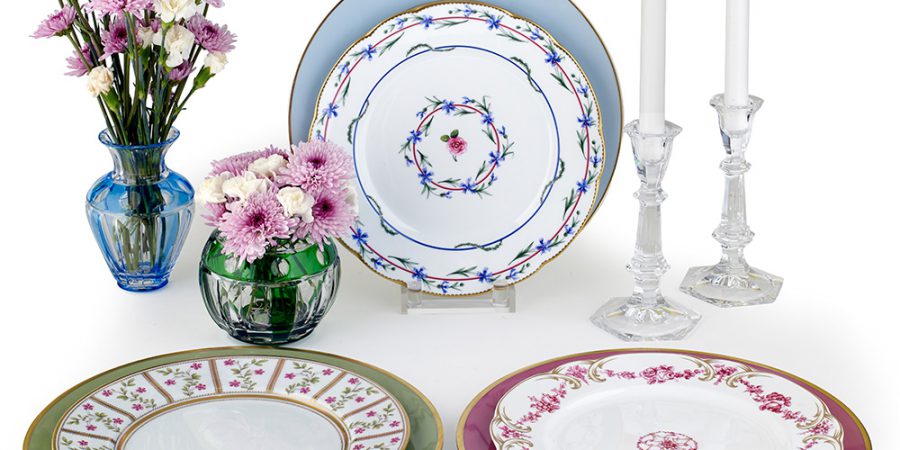Porcelain has a rich history that can be traced over 2,000 years back in time with some of the first evidence coming from the Eastern Han Dynasty in China. Since its ancient lineage, the art has found itself on all corners of the earth. Porcelain was a rarity due to the close control of the supply from China to Europe, Asia, and Africa. It was not until 1704 when German physicist Ehrenfried Walther von Tschirnhaus discovered how to create it without the necessary clay that was difficult to find outside of Asia. Since the early 1700s, porcelain caught on like wildfire in Europe, and out of that fire bore many big names such as Royal Limoges, Bernardaud, Meissen, Royal Crown Derby, and Haviland. Having such a rich history, these manufacturers have created patterns that carry on their history throughout the decades. Whether it be traditional, heritage, licensed reproduction, or in this case – Limoges Ancienne Manufacture Royale.
Bernardaud’s Limoges Ancienne Manufacture Royale consists of identical reissues of original patterns from the 18th and 19th centuries. Made to depict the history, styles, and influences of the century – each piece represents a moment in time.
Originally founded in 1737 under Louis XV and placed under the protection of the Comte D’Artois in 1774, it was sold during the revolution. Later integrated into Bernardaud in 1986, they continue to produce all the historic collections to this day.

Botanique
In 1829, the Manufacture de Sèvres was commissioned to make the Botanique collection by a man who presented himself under the name of Mr. Schaumbourg. This man was the German prince Guillaume II Hesse, who came in secret to buy a service of 566 pieces for 60 place settings, the largest ever produced by the manufacture. Each plate, created in 1831, is decorated in either nasturtium, scabious, tulip, iris, primrose, or St. John’s wort.

Louis XV
Brought to life in 1757 by the Manufacture Royale de Sèvres, the Louis XV service was used by Louis XV and then by Louis XVI. Intended for a castle, the collection held up to 620 pieces. It was also meant to decorate the king’s table daily, as evidenced by the records of the manufacture. Golden scrolls and garlands ribbon tied roses border the delicate porcelain while in the center, four “L’s” sit arranged in a star. Called “purple shades“, the color is equally as special as it is created through a mixture of silver chloride and gold.

Roseraie
This model was produced by the Clignancourt manufacture in its last decade. While flowers have been a consistent theme in the history of china, this pattern shows the progressions to a less formal motif. It shows looser arrangements and foliage with romantic accents of gold surrounding the flowers.

A La Reine
This pattern was the first produced by the Royal Manufactory after it had acquired its royal status. First issued in 1784, the design is characteristic of the second half of the 18th century and the reign of Louis XVI. The spontaneity of designs being painted lent well to concealing imperfections in the porcelain.

Le Gobelet Du Roy
The officers in the king’s household that were responsible for bread, wine, and fruit to be served are referred to as the “Gobelet”. This pattern was ordered by Louis XVI in 1783 to serve his officers at Versailles. Decorated with friezes of myrtle leaves and wild cornflowers, it reflects society’s renewed interest in nature.

Elysee
The Elysee service was produced in 1832 for the personal use of King Louis-Philippe at the Tuileries Place. The king preferred to completely replace the table setting at his residencies instead of using inherited pieces from his predecessors. Due to this, in 1842 the Sèvres Manufactory created the plate calibration method that is still used to this day to quicken creation.

Marie-Antoinette
The cornflower was a favorite of the queen who was given this design on January 2nd, 1782. It resembled the color of her eyes and she would gather fresh bouquets for the country retreat of her hamlet in the Petit Trianon. Only two of the original pieces can still be found in French national collections.

Jardin Du Roi
Created in 1783, the Jardin du Roi was inspired by the illustrations found in The Natural History of Birds by Georges Louis Leclerc de Buffon. He was a naturalist, mathematician, biologist, cosmologist, French writer, and a steward of the King’s private natural history collection. This service took examples from his most striking and colorful examples.

La Laiterie De Rambouillet
Louis XVI, a hunting enthusiast, received this design at the Rambouillet estate in 1783. This collection was designed by Jean-Jacques Lagrenée, the artistic director of the Sèvres Manufactory, and produced two years before the French revolution.

Historic Cups
The Litron cup, or “square cup”, is named after the Latin word “libra”, which is also a unit of liquid. First designed at the Vincennes factory in 1752, the cup had grown in popularity soon after and became strictly associated with the consumption of coffee.

The Limoges Ancienne Manufacture Royale is rich with history, art, colors, and royalty. Any piece from these collections will bring complete elegance and regality to the table.
